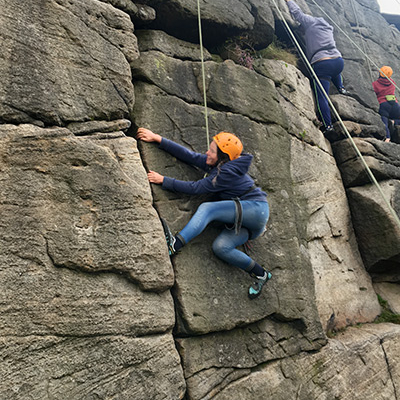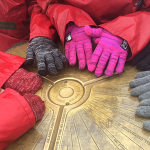Peak Rock
Eight days of climbing in the Peak District.
Mark Valentine
During the summer I ran two, four day, ‘Introduction To Rock’ climbing courses for Lupine Outdoor Adventure, four days in July and four days in August. ‘Katy’, who was the client and organizer, would be bringing a group of young people and adults, from the South-East of England to the Peak District to sample outdoor climbing for the first time having previously climbed only at indoor walls.
I began each course with a brief introduction of myself and of my climbing experience (mainly how I done most things much less than efficiently and therefore was in a position to help them avoid making the same mistakes!), before asking the group members to introduce themselves and what they expected during their stay, before I moved on to tell them what I would try to cover over the following days. This was then followed by a safety briefing. I find making everyone ‘safety aware’ by explaining any potential dangers and setting a few clear and definite rules before approaching the climbing venue is most effective as people can be easily distracted when first arriving at the crag. When the “do we have to wear a helmet?” question arose I confirmed a definite “YES” and explained that I always wear a helmet when climbing outdoors mainly due to the possibility of others knocking something from the top of the crag on to me, which was understood and accepted by all.
Then onto the actual climbing!
It was fortunate during both courses that the groups and I could be flexible with our timings, in fact it was a blessing due to the ‘changeable’ Peak District summer weather we experienced. Both course started the first day mid morning to lunchtime due to wet overnight conditions, but we managed to climb until the evening so we had a full day. If flexibility allows I don’t feel it benefits anyone having a normal 9am to 5pm day if it means spending periods of time with both myself and the clients getting wet and cold or sheltering from the elements! I chose ‘Birchen Edge’ and ‘Yarncliffe Quarry’ respectively for each of the courses first day. This allowed us to make the best of their quick drying or sheltered properties and also meant the clients were introduced to the outdoor rock in venues that were fairly ‘friendly’ for a first day. ‘Yarncliffe’ also offers an easily set up abseil next to number of possible climbing lines, which we used, on both courses.
Over the following days on both courses we dodged the weather through either starting late or early and including an extended day followed by a shorter day, we managed to only get the waterproofs out once – result!
Each course consisted of a first day of me watching everyone belay to check safe practice before I would allow them to belay unsupervised. We made a rule of doing a ‘buddy check’ before every climb to check harnesses were fitted correctly, karabiners were fastened and climbers knot was tied correctly. The group members were all well trained and showed excellent belay practice, younger more ‘slight’ individuals being tailed if belaying. After gaining an insight to general ability and group crag behavior (which was excellent) I could then explore ideas for suitable inclusive crag venues. Venues we visited were Birchen Edge, Yarncliffe Quarry, Lawrencefield and Stanage Popular during the July course, and Yarncliffe Quarry, Birchen Edge, Horseshoe Quarry and Burbage North during the August course.
Early in the courses it was apparent that a number of the climbers were attempting to ‘sprint’ up the routes as they may be able to do at an indoor wall facility, the artificial holds at in indoor wall mark the route of a climb and dictate the necessary placement so a large amount of decision making is taken away from the climber.
As the courses progressed I encouraged some of the climbers to slow their movement and also to make a conscious effort of including their eyes (for more than just a glance) in a ‘movement process’.
One ‘drill/exercise’ involved having the climber look for their next ‘hold’ then keep their eyes focused on it for a couple of seconds before making a hand/foot placement. This promotes the idea of making the best use of a selection of possible ‘holds’, making precise accurate placements whilst also resulting in controlled efficient climbing.
It was very satisfying to have the climbers listen to (what were to them) new and different climbing techniques, be willing to spend some of their trip practicing ‘drills’ and then (hopefully!) go away having added something to their climbing ‘toolbox’.
During the second course we visited Horseshoe Quarry which is a bolted sport climbing venue, making use of the bolted ‘top rings’ allowed me to set up ‘bottom ropes’ and get the group climbing quickly. We were also able set up a ‘ghost rope’ where the climbers would climb and practice clipping a ‘ghost’ lead rope whist being belayed with the safety of a top rope.
Whilst at ‘Burbage’ I was able to set up a top rope belay on a route which enabled me to belay each climber up the full climb before being able to ‘top out’ and walk off safely, this was the first time the majority had ‘topped out’ on a route and was well worth the effort of belaying a dozen climbers!
With varying ages from 8 years to adult there was a range of ability throughout both groups but everyone showed a great enthusiasm to climb and a willingness to listen to any advice that would help them improve.
Overall I was extremely impressed by both groups passion for their climbing, and also their impeccable behaviour whilst at the crag.
If you would like to book a climbing instructor for one or more days then take a look at our rock climbing pages for the sort of activities that we can provide.
Mark is one of our Regular Freelancers and is an International Mountain Leader (as well as a single pitch climbing instructor). You can follow his adventures via his twitter account https://twitter.com/yourmountainhq










